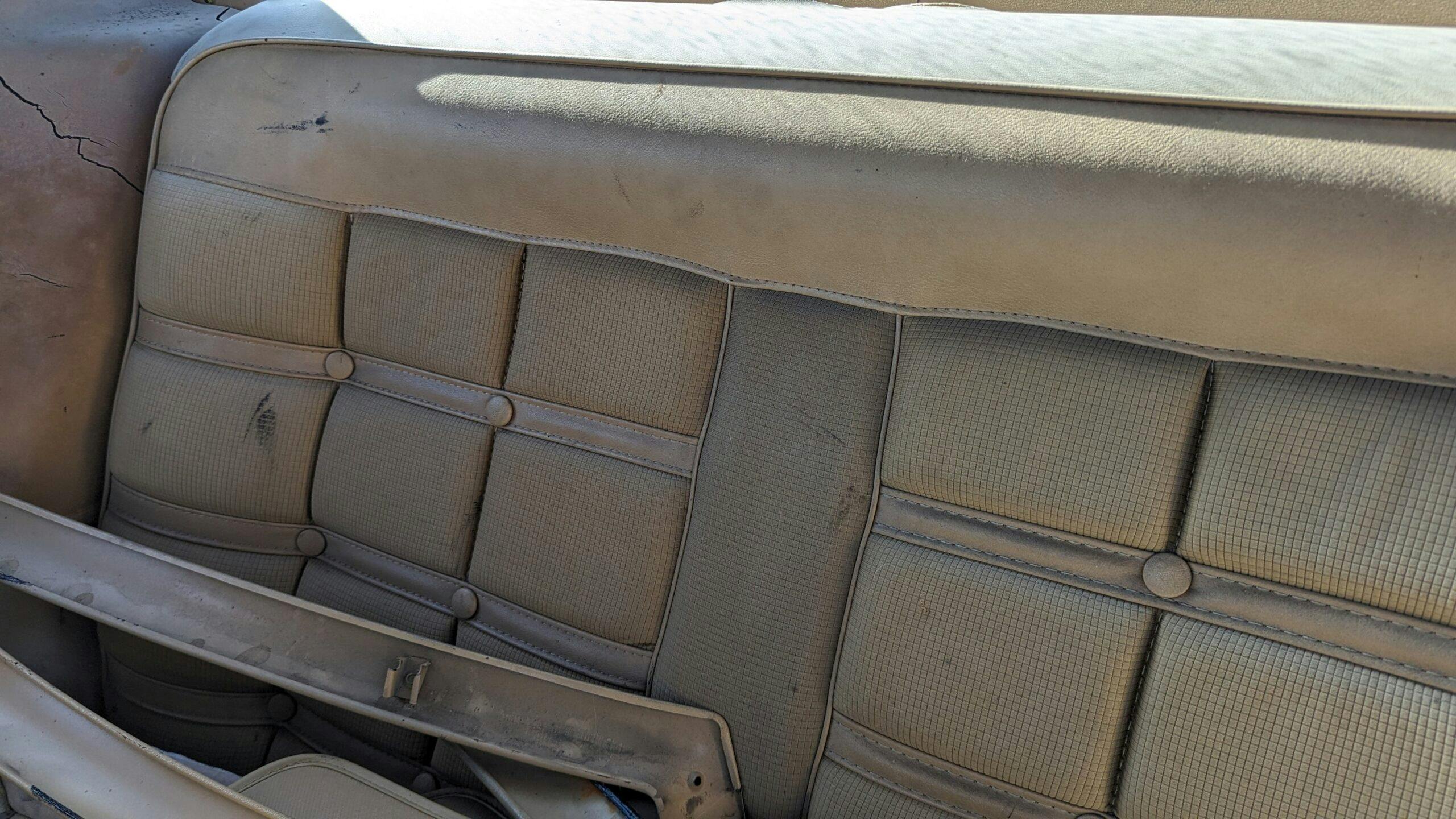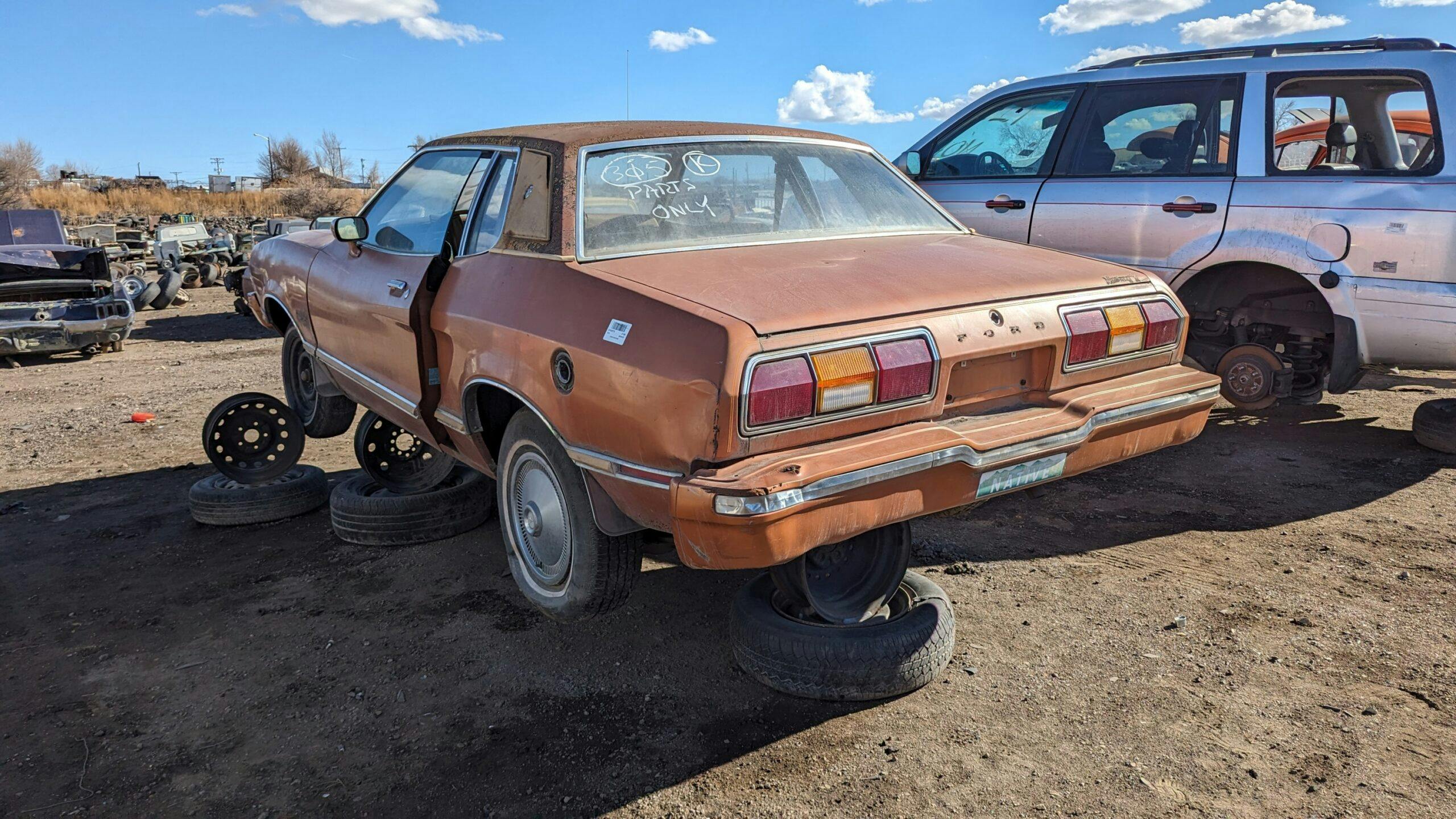Final Parking Space: 1974 Ford Mustang II Ghia Hardtop
As the first-generation Mustang got bigger, heavier, and more expensive with each passing year, Lee Iacocca (who became president of Ford in 1970) decreed that a smaller second-generation model would be developed. This car, the Mustang II, first hit showrooms as a 1974 model, which turned out to be absolutely perfect timing after the OPEC oil embargo of October 1973 caused fuel prices to go through the roof. Here’s one of those first-year cars, found in a Denver-area self-service yard recently.

The original Mustang was designed as a sporty-looking commuter based on Ford’s smallest North American–market car of its time, the Falcon. The second-generation Mustang was based on a platform derived from Ford’s smallest North American–market car at that time: the Pinto.

This adaptation made sense from an engineering standpoint, since the Pinto used a modern lightweight design and was set up to use efficient engines from Ford’s European operations. The Mustang II’s chassis differed from the Pinto’s in significant ways—the most important being the wheelbase, which was longer—but the idea of a Mustang that shared ancestry with a tiny economy car originally designed to compete against the likes of the Volkswagen Beetle and Toyota Corolla caused—and still causes—discomfort to some enthusiasts.

None of this really mattered in the American Ford showrooms of 1974, where the Mustang II was an instant success. Sales of the 1974 Mustang were nearly triple those of the 1973 model, and they remained respectable throughout the Mustang II’s production run from 1974 to ’78. Some Mustang II sales may have been cannibalized by Ford’s own Capri, which was badged as a Ford in its European homeland but sold through Mercury dealers (without Mercury badging) in the United States; the Capri was a few hundred pounds lighter and shared the inline-four and V-6 engines used by the Mustang II.

The 1974 Mustang II was available with a choice of two engines: a 2.3-liter, single overhead-cam four-cylinder and a 2.8-liter pushrod V-6, both designed in Europe and both destined for long and successful careers in the global Ford Empire. This car has the 2.3.

This engine was rated at 85 horsepower, while the V-6 made 105 horses. Power numbers were down across the board for new cars sold in the United States when this car was built, due to stricter emissions and fuel-economy standards plus the switch from gross to net power ratings that had been mandated a couple of years earlier. Even so, the 2.3-powered 1974 Mustang II had a better power-to-weight ratio than the 1973 Mustang with the base 250-cubic-inch straight-six engine, and it boasted far superior handling and braking.

A four-speed manual transmission was base equipment in the Mustang II, and that’s the gearbox in this car. A three-speed automatic was available as an option.

1974 was the only model year in which there was no V-8 engine available in the Mustang, which stung. For the 1975 through 1978 model years, a 302-cubic-inch V-8 was available as a Mustang II option.

Another thing that made 1974 unpleasant for owners of Mustang IIs (and owners of all new cars sold in the United States for that model year) was the much-hated seat-belt starter interlock system. If all front-seat occupants (or grocery bags) weren’t wearing their belts, the car wouldn’t start; this sounded sensible in theory, but most Americans refused to wear seat belts at that time and the technology of 1974 made the system maddeningly malfunction-prone.

This car is a Ghia, the most expensive new Mustang II model of 1974. The Ghia package included a padded vinyl roof and a snazzier interior; its MSRP for ’74 was $2866 (about $18,866 in 2024 dollars).

The Ghia name came from Carrozzeria Ghia, an Italian coachbuilder and design house founded in 1916. Ghia was behind such beautiful machines as the Fiat 8V Supersonic, Renault Caravelle, and the Chrysler Turbine. The company ended up in the hands of Alejandro de Tomaso, who sold it to Ford in 1970. After that, Ford used the Ghia name to designate luxury trim levels on its vehicles throughout the world; in the United States, car shoppers could get Granadas and even Fiestas with Ghia badges.

This car has the “Westminster cloth” seat upholstery and shag carpeting that came with the Mustang II Ghia package.

The interior in this one is still in decent enough condition for its age, though junkyard shoppers have purchased the door panels.

The radio is a Philco AM/FM/eight-track stereo unit, likely installed by the dealer but perhaps by an aftermarket shop. It would have been very expensive in 1974, but worth it in order to listen to the Mustang-appropriate hits of that year.

According to the build tag, this car was built at the storied River Rouge plant in Michigan in April of 1974. The paint is Saddle Bronze Metallic, the interior is Tan, and the differential ratio is 3.55:1. Interestingly, the DSO code shows that the car was built for export sale. What stories could it tell of its travels?

The High Plains Colorado sun is murder on vinyl tops, and this one got nuked to oblivion long ago.

For the 1979 model year, the Mustang II was replaced by a third-generation Mustang that lived on the versatile Fox platform. Ford nearly replaced that Mustang with one based on a Mazda-sourced front-wheel-drive platform, but ended up keeping the Fox going through 1993 (or 2004, if you consider the Fox-descended SN95 platform to be a true Fox) and sold its Mazda-based sports coupe as the Probe. For what it’s worth, a stock V-6 Probe will eat up a stock same-year V-8 Fox Mustang on a road-race course; I’ve seen it happen many times in my capacity as Chief Justice of the 24 Hours of Lemons Supreme Court (the Fox Mustang has a pronounced advantage over the Probe on the dragstrip, though).

Worth restoring? You decide! The good news is that this yard will, unusually, sell whole cars. Perhaps someone will rescue this Mustang II from its inevitable date with The Crusher.
***
Check out the Hagerty Media homepage so you don’t miss a single story, or better yet, bookmark it. To get our best stories delivered right to your inbox, subscribe to our newsletters.























If this 1974 Ford Mustang II Ghia Hardtop Could Talk, What Would it Say?
“Put me out of my misery.”
What did it say? I clearly heard it: “Just shoot me.”
Perspective and retrospective are two interesting siblings. As mentioned, the much maligned Mustang II is finally getting the respect it deserves as the right Mustang for it’s time. When you have an iconic model like the Mustang coming up on it’s 60th Birthday, it can be easy to draw comparisons with evolutions that followed and be critical. But if one keeps the “times” that each iteration was created in and for, they all positively and respectfully represented the brand. Are you listening John Clor…
The fastback wasn’t bad looking with some larger wheels.
Saw one at a track day at VIR a few years back.
A Mustang II that still has a front suspension! Will wonders never cease.
After growing up in a Ford family of the ’60’s with true muscle cars, the Mustang II was surely a let down. We got one in ’74 and I proceeded to beat the snot out of that “Pinto on steroids”. After having Mach’s and Boss’s that would get rubber out of 4 gears, we would run the Mustang II up the bus lane at high school and while the driver was shifting into 2nd, the passenger would yank up on the parking brake for a split second appearing to squawk the tires at an unbelievably slow speed. High school shenanagans!!!
Honestly, the fact that it’s a manual already makes it a big draw to me, at least–any Mustang of any era that shows up on the marketplace near me is inevitably a slushbox, which on the winding backstreets of the Ohio Valley is a big detriment. With a body that straight, all I’d need is parts from a Thunderbird Turbo Coupe or a Merkur to make one helluva sleeper. A shame, then, that I’m dead broke.
Would say “Please just kill me now”. Had a loaner ‘stang II. It had the patented Ford hard plastic smell that required keeping the windows cranked down 24/7 365 days to prevent a trip to the ER. Not fun to ride or run even when it was free.
OMG this was my car in college in the ’80s! Donated by my beloved uncle. It was very 1970s and not au courant. The drivers seat floor latch snapped so the driver seat slid back and forth on rails. It got infested with cockroaches (Miami, and I was kind of a clutter kid). Looking back I would kill to steal just 5 minutes driving the old girl.
Actually the 1974 mustang II did come with a v8. Just wasn’t offered domestically but was offered in the Mexican Mustang II cause it didn’t have to meet the strict EPA
My first car in 78′ was a 74′. You never forget ur first. I’d die to have her back…